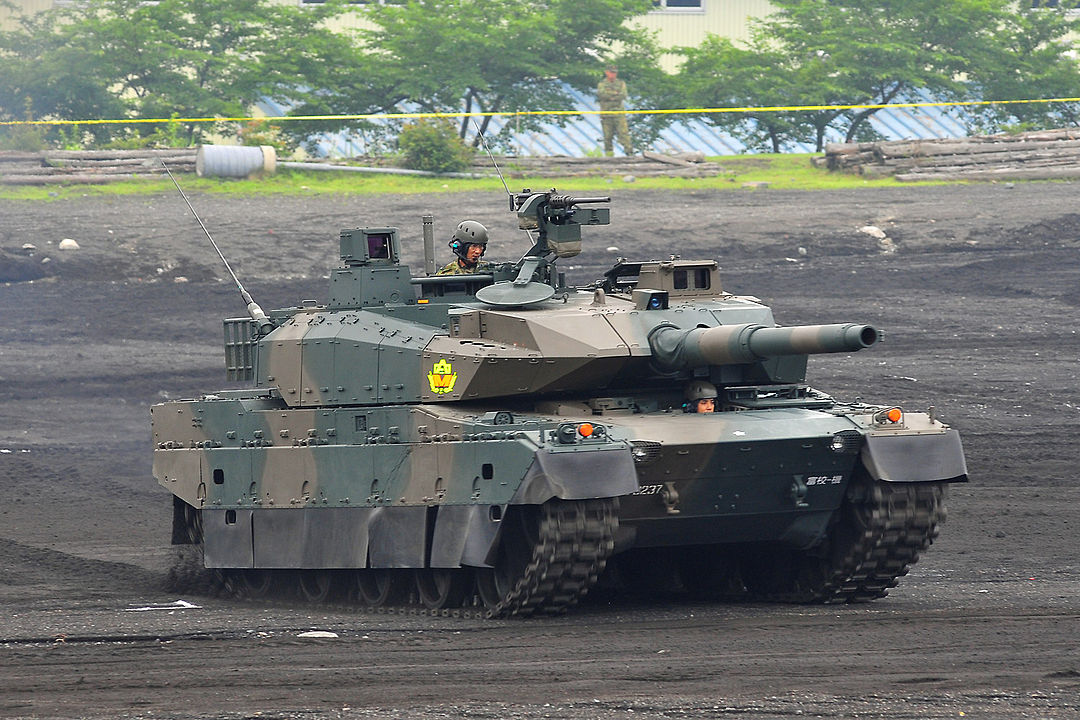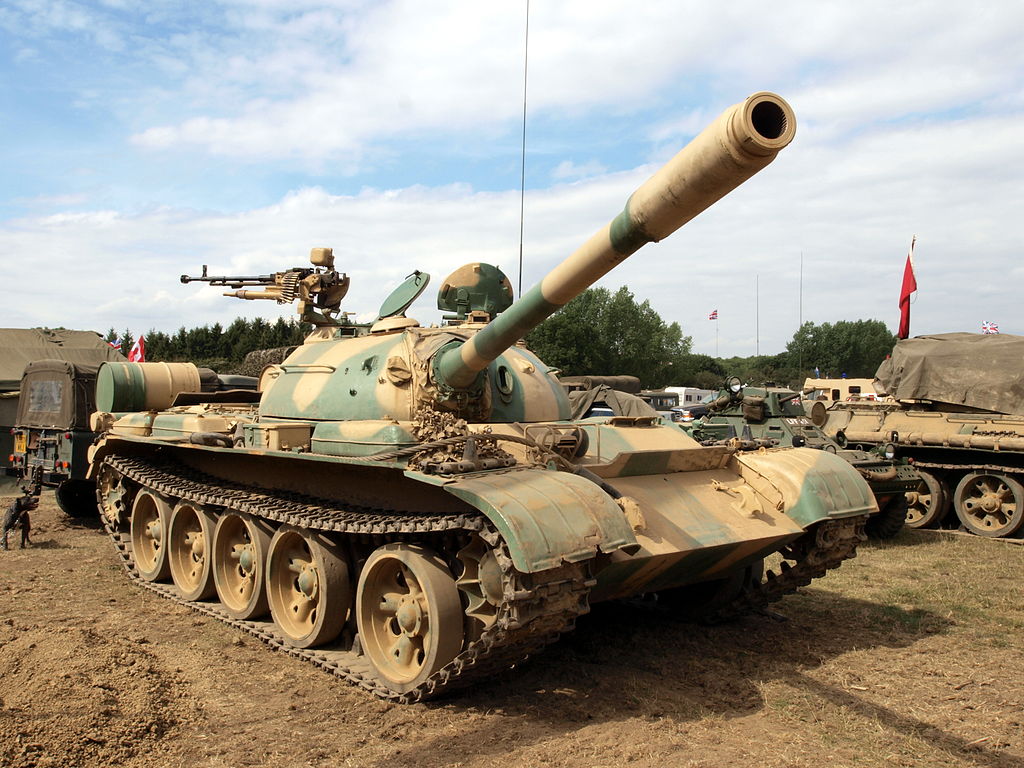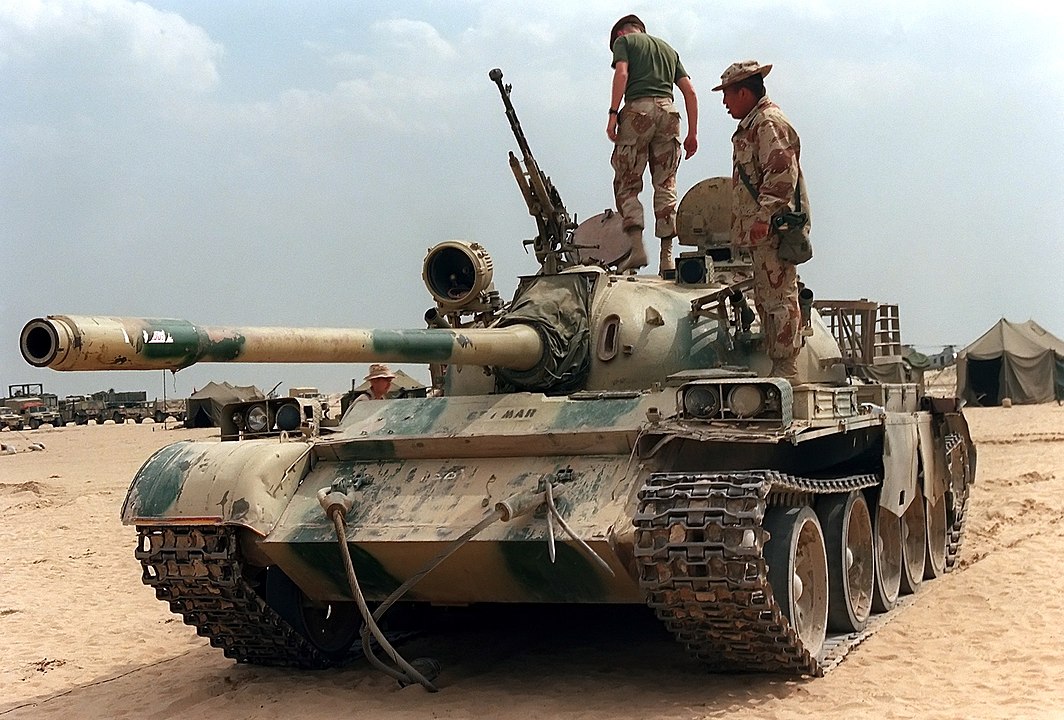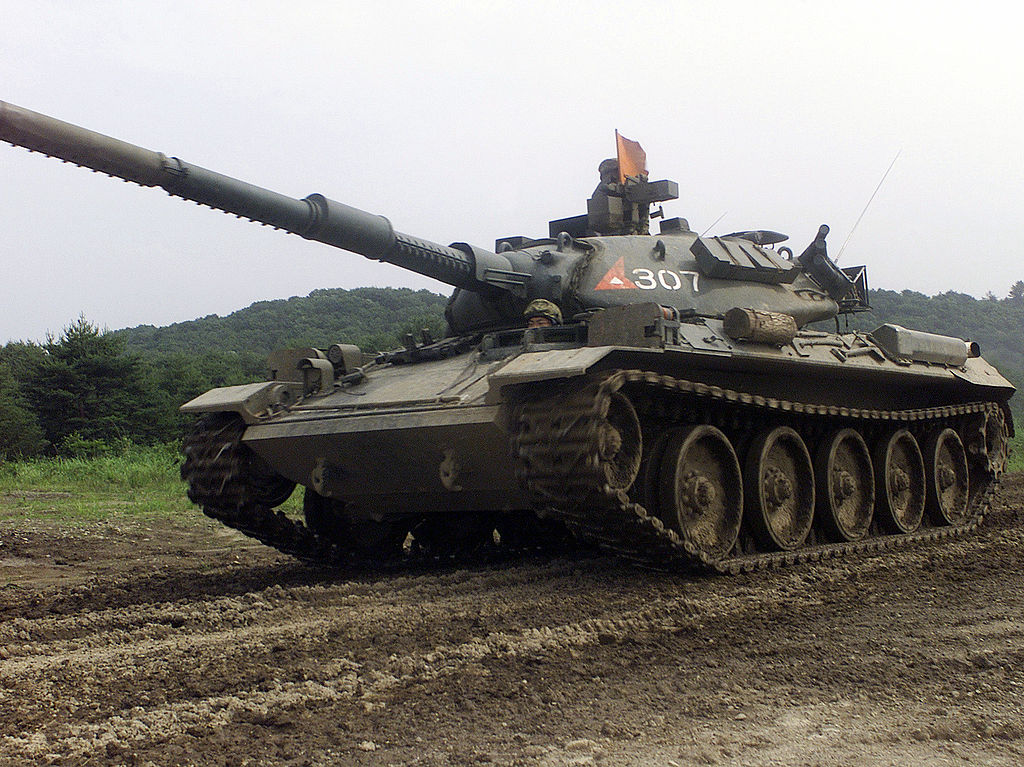
Un aperçu des mots-clés relatifs au trafic. Ici, vous pouvez facilement rechercher des mots-clés et des définitions que vous ne connaissez pas encore.
More subjects
The TR-85 is a main battle tank designed for the armed forces of Romania. Based on the TR-77-580, the TR-85 tank was developed from 1978 to 1985 and produced from 1986 until 1990. A modernization program was initiated in March 1994 to upgrade the TR-85 tanks to NATO standards. The result was the TR-85M1 Bizonul ('Bison') third-generation main battle tank, currently the most modern tank in service with the Romanian Land Forces. Although a further development of the T-55, the TR-85M1 uses a T-block powerpack (similar to the one used in the Leopard 1) based on a V8 German 830 hp (620 kW) diesel engine, an improved turret, a locally-designed 'Ciclop' fire control system (with cross-wind sensor, laser rangefinder and night vision), new 100 mm BM-412 Sg armour-piercing fin-stabilized discarding sabot (APFSDS-T) projectiles and a fully redesigned suspension with 6 road wheels on each side, protected by metal side skirts. Combat weight is 50 tons. (Source: Wikipedia.org, CC BY-SA)
The Type 10 (10式戦車, Hitomaru-shiki sensha) is a fourth generation main battle tank of JSDF produced by Mitsubishi Heavy Industries for the Japanese Ground Self Defense Force, entering service in 2012. Compared with other currently-serving main battle tanks in the JGSDF, the Type 10 has been equipped with enhancements in its capability to respond to anti-tank warfare and other contingencies. The TK-X (MBT-X) project aimed to produce the new Type 10 main battle tank, to replace or complement the existing Type 74 and Type 90 main battle tanks that are currently in service with the Japan Ground Self Defense Force. Development began in the 1990s, and production was expected to start in 2010–2011. A prototype was revealed on February 13, 2008 at the Technology Research and Development Institute (TRDI) in Sagamihara. Heavy emphasis was placed on C4I capabilities as well as on performance, firepower, protection and mobility. (Source: Wikipedia.org, CC BY-SA)
 © Wikimedia.org/T.Goto, CC0
© Wikimedia.org/T.Goto, CC0
The Type 59 (Chinese: 59式; pinyin: Wǔ jiǔ shì; industrial designation: WZ-120) main battle tank is a Chinese-produced version of the Soviet T-54A tank, an early model of the ubiquitous T-54/55 series. The first vehicles were produced in 1958 and it was accepted into service in 1959, with serial production beginning in 1963. Over 10,000 of the tanks were produced by the time production ended in 1985 with approximately 5,500 serving with the Chinese armed forces. The tank formed the backbone of the Chinese People's Liberation Army armoured units until the early 2000s, with an estimated 5,000 of the later Type 59-I and Type 59-II variants in service in 2002. The Type 59 was modified several times during its service. It was also the basis of several later Chinese tank designs including the Type 69 and Type 79 tanks. (Source: Wikipedia.org, CC BY-SA)
 © Wikimedia.org/Alf van Beem, CC0
© Wikimedia.org/Alf van Beem, CC0
The Type 61 tank (61式戦車, Roku-ichi Shiki sensha) is a main battle tank developed and used by the Japan Ground Self-Defense Force (JGSDF), built by Mitsubishi Heavy Industries. Development started in 1955 and the vehicle was first deployed in April 1961. The type number follows the year of deployment. A total of 560 Type 61s were manufactured between 1961 and 1975, when production ceased. It was succeeded by the Type 74. The Type 61 is conventionally laid out, with a central turret and the engine located at the rear of the hull. The tank has a crew of four: a commander, driver, gunner and loader. The hull is welded steel, with a cast steel turret. The maximum armour thickness is quoted as 64 millimeters. The driver sits at the front right of the hull, with a hatch immediately above him, and three vision periscopes covering the forward arc. To the driver's left is the transmission, which can be accessed for servicing by removing a large panel on the front of the hull. The commander and gunner sit in the turret on the right side, with the commander provided with a large domed cupola with a hatch on the rear of it. The gunner does not have a hatch and is seated forward of the commander. (Source: Wikipedia.org, CC BY-SA)
The Type 69 (Chinese: 69式; pinyin: Liùjiǔ shì) and Type 79 (Chinese: 79式; pinyin: Qījiǔ shì) are Chinese first generation main battle tanks. Both were developments of the Type 59 medium tank (a locally produced Soviet T-54A) with technologies derived from T-62. They were the first indigenously developed main battle tanks by China, although also classified as medium tanks while in development and service. Their lineage from the T-54A can be seen through the distinct gap between the first and second road wheels. Other improvements included a new engine, ballistic computers, and laser rangefinders. The more advanced Type 79 variant was equipped with a 105 mm rifled gun which was also found on the Type 80 tank. (Source: Wikipedia.org, CC BY-SA)
 © Wikimedia.org, CC0
© Wikimedia.org, CC0
The Type 74 (74式戦車, nana-yon-shiki-sensha) is a main battle tank (MBT) of the Japan Ground Self-Defense Force (JGSDF). It was built by Mitsubishi Heavy Industries as a supplement to the earlier Type 61. It was based on the best features of a number of contemporary designs, placing it in the same class as the US M60 Patton or German Leopard 1. Like these designs, it mounts the M68 rifled 105 mm gun. The design did not enter widespread use until 1980, by which point other Western forces had introduced more capable designs. It was followed by the heavier Type 90. Both the Type 74 and Type 90 are supplemented and will be eventually replaced by the new-generation Type 10 tank. (Source: Wikipedia.org, CC BY-SA)
 © Wikimedia.org, CC0
© Wikimedia.org, CC0
The Type 96 (Chinese: 96式; pinyin: Jiǔliù shì) or ZTZ96 is a Chinese second generation main battle tank (MBT). The final evolution of the Type 88 design, the Type 96 entered service with the People's Liberation Army (PLA) in 1997. The later variants of the Type 96 are currently in PLA service together with China's third generation MBT, the Type 99. China's tank development can be divided into three generations. The first generation was the Type 59, a locally manufactured copy of the Soviet T-54 and its derivative tanks. The second generation of MBTs started with the Type 80 and reached its end state as the Type 96. The third generation began with the Type 99 tank. China's first generation tank development program failed to meet the PLA's performance requirements. These technical shortcomings coincided with the appearance of the T-72 and T-80 tanks in Russia, which influenced Chinese defense officials and contributed to their decision to begin development of a new generation indigenous MBT in the early 1980s. This new program was to lead to the development of the Type 80/85 family by 1988. (Source: Wikipedia.org, CC BY-SA)
The Type 99 (Chinese: 99式主战坦克; pinyin: Jiǔjiǔshì Zhǔzhàn Tǎnkè) or ZTZ-99 is a Chinese third generation main battle tank (MBT). The vehicle was a replacement for the aging Type 88 introduced in the late 1980s. The Type 99 MBT was China's first mass-produced third-generation main battle tank. Combining modular composite armour and tandem-charge defeating ERA, 125 mm smoothbore gun with ATGM-capability, high mobility, digital systems and optics, the Type 99 represents a shift towards rapid modernization by the PLA. The Type 99 is based on the Soviet T-72 chassis. The tank entered People's Liberation Army (PLA) service in 2001. The People's Liberation Army Ground Force (PLAGF) is the sole operator of the Type 99. Three main versions of the Type 99 have been deployed: the Type 98 prototype, Type 99 and the Type 99A. The Type 99 forms the core of China’s modern maneuver combat capabilities, with over 1,200 tanks built for the past two decades. (Source: Wikipedia.org, CC BY-SA)
The VT-4 (Chinese: VT-4主战坦克; pinyin: VT-4 zhǔzhàn tǎnkè), also known as the MBT-3000, is a Chinese third generation main battle tank built by Norinco for overseas export. During the development of Type 90-II/Al-Khalid (also known as MBT-2000) in the 1980s, the gearbox and engine were originally imported from Germany, but this plan was abandoned due to a Western arms embargo. The powertrain instead was sourced from Ukraine, the same for most Chinese export vehicles at the time. China eventually developed domestic powertrains, which led to the creation of the MBT-3000 program for export customers. MBT-3000 was the successor of the Type-90II (MBT-2000) export tank. The MBT-3000 project later named as VT-4 began development in 2009 as a co-operation with First Inner Mongolia Machinery Factory and other companies. The MBT-3000 concept debuted at the 2012 Eurosatory. The tank was subsequently shown at the 2014 Norinco Armor Day and the 10th China International Aviation & Aerospace Exhibition as the VT-4. (Source: Wikipedia.org, CC BY-SA)
The Vijayanta (en: 'Victorious') was a main battle tank built in India based on a licensed design of the Vickers Mk.1. The Vijayanta was the first indigenous tank of the Indian Army. The prototype was completed in 1963 and the tank entered service on December 29, 1965. The first 90 vehicles were built by Vickers in the UK. Production continued at the Heavy Vehicles Factory in Avadi until 1983 with 2,200 being built. The Vijayanta was first made in the UK before production moved to India. Indian production got underway, allowing UK production to cease. The Vijayanta was to be phased out by the Indian Army by 2008 (the decision to phase out 296 'pre Mark 1A tanks' was already taken in 1997). In 1997 the plan to repower the Vijayanta was shelved. The overhauling of the fleet was discontinued from the year 1999–2000 as the withdrawal from service of the Vijayanta had already been approved. Bulk production of Vijayanta spares ended in 1989. A number of the tank hulls were converted to other uses such as self-propelled guns after being withdrawn from service. The Vijayanta has been supplemented by the T-72M1 in Indian service. (Source: Wikipedia.org, CC BY-SA)

Time for recess! Post a comment, ask a question or write a review. Feel free to let us know what you think!
Les français faites attention, de base ce site est en flamand, et a été traduit en français par Google traduction, il se peut que vous ayez des questions très bizarre avec les vitesse minimale etc. Faites super attention ou alors allez directement sur un autre site pour apprendre votre permis de conduire
Tres intéressant , ça aide énormément pour bien analyser les questions et les réponses. Merci bcp
Termes pièges: "faits saillants" ?; "régulateur de vitesse": sur ma R4L?; "basse pression des pneus": idem sur ma R4L?; "tous les conducteurs doivent s'arrêter et quitter l'intersection": Quelle intersection?; "lumières tamisées" pour "feux de croisement"?
Carte du Permis de Conduire Classic AB Routiére Gillera Runner Dynamic Américaine
AUJOURD HUI J AI RATER LA THEORIQUE SUR LE DEBUT SUR 54 QUESTION 3 FAUTE GRAVE COMMENT OBTENIR MON PERMIE
Que je clique n'importe ou, j'ai des textes en flamand du genre "De door u aangevraagde pagina kon niet geladen worden Indien u deze url zelf ingetypt heeft, check of deze correct is Klik hier om naar de homepagina te gaan." Il n'y a pas moyen de le mettre en Francais, c'est de la discrimination !
La question sur la pente est pas claire, la pente est la descente tandis que pour une montée c'est une côte.
Bonjour ! C’est un peu difficile toutes ces règles. Contactez-nous si voulez obtenir un permis de conduire original en 2 jours seulement. Whatsapp: 33644696684 Snapchat: permis.conduire
C’est un peu difficile toutes ces règles. Contactez-nous si voulez obtenir un permis de conduire original en 2 jours seulement. Whatsapp: 33644696684 Snapchat: permis.conduire
Je suis vraiment fatiguée j'ai n'arrivais même pas reçu mon code de la route j'ai besoin de Ed SVP merci d'avance
bonjour à tous svp est ce que je peux compter sur ce site pour mon permis de la semaine prochaine . MERCI
Pas de vitesse minimale sur l'autoroute? Je suis étonné. Je pensais qu'il s'agissait de 70 km/hr.
C'est un peu dificir d'etudies de règles de lå circulation sur internet, ici en Sweden pas de livres en france alors comment nous devon faire?
j'ai eu 1/ fin de l'autoroute 2/ fin de l'autoroute 3/ x 4/ y je prends la réponse 1, on me dit que j'ai faux et que j'aurais dû choisir 2... "lumière tamisée" pour feux de croisement, traduction vraiment approximative... Bon en gros c'est juste un quizz panneaux, ça me permet de découvrir un peu, mais je reste sceptique sur la qualité du tout. Je remercie l'effort.
Hello, J'ai repassé le test après des années pour me tester, mais... 1) Les questions ne sont pas précises. 2) Certaines fautes sont à déplorer (p.ex "Vitesse minimale sur une autoroute => 70km/h. Réponse du site : "Aucune limitation minimale")
47/50 Bon site mais certain terme dans l'examen sont pas precis/ pas les meme que dans le vrai examen
Site attractif dans sa conception; cependant nécessite plus de sérieux et d'actualisation sur les questionnaires. Des formulations pas du tout correctes( dû certainement à une maivaise traduction en français. ce qui enduit en erreur l'apprenant qui est pourtant là pour plus de clarté et de précisions). Des réponses à des questions qui se contredise: exemple; la question sur quand on consomme plus de carburant, quelque part on te dit à basse vitesse, ailleurs à haute vitesse..on se fie à quoi dans ce cas? La liste étant exhautive.. Merci de reviser cette plateforme et y apporter les ajustements nécessaires car les gens payent pour apprendre sérieusement et non pas pour être plus embrouillés. Positivement!
46/50 super bon exercice et bon site Faut à la question: que indique ce panneau (autoroute) 2x la même réponse donc eu faut car j'ai selectionnée une des deux et pas la bonne et sur l'autoroute j'ai été vérifier, il est bien marquer 80km/h Mais sinon super bon site un grand merci ;-))
pour moi qui doit passer mon permis de conduire j'ai fais un 46 sur 50 et des bonnes questions
Bonjour, il y a un jour ou deux j'ai croisé la route de chasseurs qui faisaient une battue... ils avaient mis des panneaux au bord de la route (style " battue en cours") Est ce que la vitesse autorisée entre ces panneaux est la vitesse "normale" de circulation ou est ce qu'il y a une vitesse d' "exception"..? ( j'étais a 70 Km/h sur une route a 90 Km/h et les chasseurs me faisaient des signes "genre je roulais trop vite"...) Merci de votre réponse. BAV.
nouveaux nom pour les feux : apres verification a vias connait pas saillants ou tamisé( nouvelle invention ou traduction erronée
question des feux tamisé ou saillant n existe pas: feux de croisements ou de route
beaucoup d'erreurs de traduction. question ne correspondent pas aux panneaux, autoroutes/routes ordinaire.
La question sur la vitesse minimal sur l'autoroute est fausse. Il indique la correct étant comme "Il n'y a pas vitesse minimal", alors que de savoir, et après vérificaiton, elle est en faite à 80KM/H
la question 33 que de ce questionnaire était fausse pour ma part : elle déclare que le panneau C25 (selon le Feu Vert, 14 ème édition, 2019) est un panneau réglementant le stationnement, alors que selon l'ouvrage précité, il place une interdiction de passage pour les véhicules ou train de véhicules ayant une longueur supérieure à celle indiquée sur le panneau.